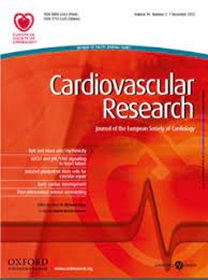Abnormal circadian rhythms exacerbate dilated cardiomyopathy by reducing the ventricular mechanical strength
IF 10.2
1区 医学
Q1 CARDIAC & CARDIOVASCULAR SYSTEMS
引用次数: 0
Abstract
Aims Dilated cardiomyopathy (DCM) has etiological and pathophysiological heterogeneity. Abnormal circadian rhythm (ACR) is related to the development of DCM in animal models, but exploration based on clinical samples is lacking. Sleep apnea (SA) is the most common disease related to ACR, and we chose SA as the study object to explore ACR-DCM. Methods and results We included a derivation cohort (n =105) and a validation cohort (n = 65). DCM patients were divided into SA and without SA group. RT-qPCR was used to determine the change of rhythm gene expression pattern of heart samples from different timepoints. We used single-nucleus RNA sequencing (snRNA-seq) to explore the abnormal transcriptional patterns in the ACR group, and we verified the findings by pathological staining, atomic force microscopy (AFM), and Rev-erbα/β knockout (KO) mice analysis. DCM patients with SA showed decreased amplitude of rhythm gene expression. SA group showed more severe dilation of left heart chambers. From snRNA-seq, ACR-DCM lost the morning transcriptional patterns, detailly, actin cytoskeleton organization of cardiomyocytes (CMs) disrupted and hypertrophy aggravated, and the proportion of activated fibroblasts (Fibs) decreased with the reduction of fibrotic area ratio. The results of pathological staining, mechanical experiments, and transcriptional feature of Rev-erbα/β KO mice supported the above findings. Conclusion Compared with the non-SA group, left ventricular (LV) wall dilation was more severe and the structural strength was lower in DCM patients with SA, and phenotypic changes in CM and Fib were involved in this process. ACR-DCM was histopathologically characterized by a structurally weak ventricular wall.昼夜节律异常会降低心室机械强度,从而加重扩张型心肌病的病情
目的 扩张型心肌病(DCM)具有病因学和病理生理学异质性。在动物模型中,昼夜节律异常(ACR)与 DCM 的发生有关,但缺乏基于临床样本的研究。睡眠呼吸暂停(SA)是与 ACR 相关的最常见疾病,因此我们选择 SA 作为研究对象来探讨 ACR-DCM。方法和结果 我们纳入了一个衍生队列(n = 105)和一个验证队列(n = 65)。DCM 患者分为有 SA 组和无 SA 组。采用 RT-qPCR 方法测定不同时间点心脏样本中节律基因表达模式的变化。我们使用单核 RNA 测序(snRNA-seq)来探讨 ACR 组的异常转录模式,并通过病理染色、原子力显微镜(AFM)和 Rev-erbα/β 基因敲除(KO)小鼠分析来验证研究结果。患有SA的DCM患者的节律基因表达振幅降低。SA组左心室扩张更严重。从snRNA-seq的结果来看,ACR-DCM失去了晨间转录模式,具体表现为心肌细胞(CMs)肌动蛋白细胞骨架组织破坏,肥大加重,活化成纤维细胞(Fibs)比例下降,纤维化面积比缩小。Rev-erbα/β KO 小鼠的病理染色、力学实验和转录特征结果支持上述发现。结论 与非SA组相比,SA组DCM患者的左心室壁扩张更严重,结构强度更低,CM和Fib的表型变化参与了这一过程。ACR-DCM 的组织病理学特征是心室壁结构薄弱。
本文章由计算机程序翻译,如有差异,请以英文原文为准。
求助全文
约1分钟内获得全文
求助全文
来源期刊

Cardiovascular Research
医学-心血管系统
CiteScore
21.50
自引率
3.70%
发文量
547
审稿时长
1 months
期刊介绍:
Cardiovascular Research
Journal Overview:
International journal of the European Society of Cardiology
Focuses on basic and translational research in cardiology and cardiovascular biology
Aims to enhance insight into cardiovascular disease mechanisms and innovation prospects
Submission Criteria:
Welcomes papers covering molecular, sub-cellular, cellular, organ, and organism levels
Accepts clinical proof-of-concept and translational studies
Manuscripts expected to provide significant contribution to cardiovascular biology and diseases
 求助内容:
求助内容: 应助结果提醒方式:
应助结果提醒方式:


